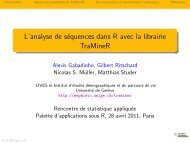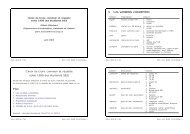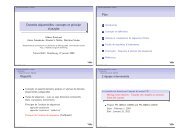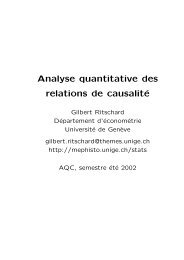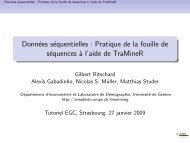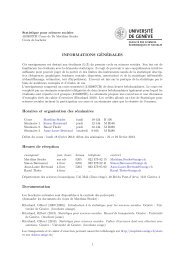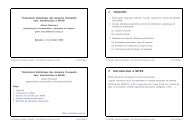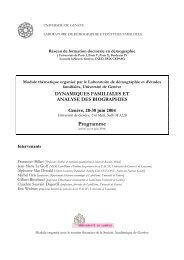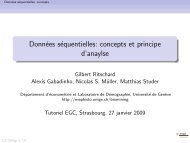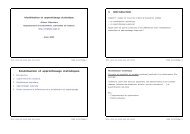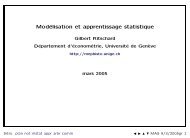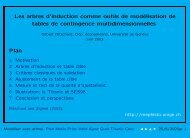Extraction de règles d'association séquentielle à l'aide de modèles ...
Extraction de règles d'association séquentielle à l'aide de modèles ...
Extraction de règles d'association séquentielle à l'aide de modèles ...
- No tags were found...
Create successful ePaper yourself
Turn your PDF publications into a flip-book with our unique Google optimized e-Paper software.
Règles d’association <strong>séquentielle</strong> et <strong>modèles</strong> <strong>à</strong> risques proportionnelsHougaard, P. (2000). Analysis of Multivariate Survival Data. New York: Springer-Verlag.Lallich, S. et O. Teytaud (2004). Evaluation et validation <strong>de</strong> l’intérêt <strong>de</strong>s <strong>règles</strong> d’association.Revue <strong>de</strong>s Nouvelles Technologies <strong>de</strong> l’Information RNTI-E-1, pp. 193–218.Lenca, P., P. Meyer, B. Vaillant, P. Picouet, et S. Lallich (2004). Evaluation et analyse multicritères<strong>de</strong>s mesures <strong>de</strong> qualité <strong>de</strong>s <strong>règles</strong> d’association. Revue <strong>de</strong>s Nouvelles Technologies<strong>de</strong> l’Information RNTI-E-1, pp. 219–246.Mannila, H., H. Toivonen, et A. I. Verkamo (1997). Discovery of frequent episo<strong>de</strong>s in eventsequences. Data Mining and Knowledge Discovery 1(3), 259–289.Ritschard, G., A. Gabadinho, N. S. Müller, et M. Stu<strong>de</strong>r (2008). Mining event histories: Asocial science perspective. International Journal of Data Mining, Mo<strong>de</strong>lling and Management1(1), 68–90.Schaffer, J. (1995). Multiple hypothesis testing. Annual Review of Psychology 46, 561–582.Srikant, R. et R. Agrawal (1996). Mining sequential patterns: Generalizations and performanceimprovements. In P. M. G. Apers, M. Bouzeghoub, et G. Gardarin (Eds.), Proc.5th Int. Conf. Extending Database Technology, EDBT, Volume 1057, pp. 3–17. Springer-Verlag.Therneau, T. et P. Grambsch (2000). Mo<strong>de</strong>ling Survival Data: Extending the Cox Mo<strong>de</strong>l. NewYork: Springer-Verlag.Yamaguchi, K. (1991). Event History Analysis, Volume 28 of Applied Social Research MethodsSeries. Newbury Park: SAGE.Zaki, M. J. (2001). SPADE: An efficient algorithm for mining frequent sequences. MachineLearning 42(1/2), 31–60.SummaryAssociation rules mining is a thriving research field in data mining. These methods canalso be applied to sequential data. Two problems arise when one wants to apply associationrules mining to sequential data. First, the main criterium used to extract sequential patternsis their frequency. However, two events might be strongly associated even if they do nothappen frequently. Second, association rules measures do not take into account the temporalaspect of sequential data, like the importance of the duration between two events or theproblem of censured obsevations. In this article, we propose a method to extract significantassociations between events using duration mo<strong>de</strong>ls. Association rules are extracted from eachsequential pattern observed in a set of sequences. Then, the influence on the risk that the “conclusion”event occurs after the “premise” event(s) is estimated using a proportional hazardsemi-parametric duration mo<strong>de</strong>l. This paper presents the method and a comparison with someclassical association measures.



